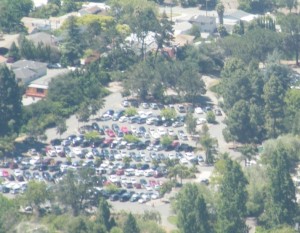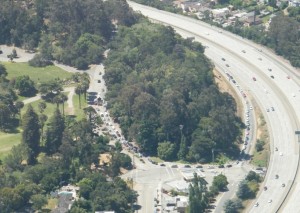During the multiple public hearings leading up to City Council approval of the Zoo’s “conservation” theme park in June, 2011, we heard a lot of talk about the environmental review document for the proposed development. Waving around a City-prepared report that comprised hundreds of pages, some development enthusiasts claimed that the environmental impacts of the project had been subjected to an unusually thorough level of scrutiny. Well, don’t buy it. The problem is that in environmental review, it is quality—not quantity—that really matters. This report is one huge hunk of Swiss cheese: riddled with holes big enough to drive an elephant through.
First is the matter of the type of report the City chose to prepare. The City called its document a “Subsequent Mitigated Negative Declaration Addendum” (SMND/A). This mouthful was developed as a hybrid term to avoid preparing a new, full Environmental Impact Report (full EIR) as the project most certainly warranted. There is no provision for preparing a “SMND/A” under the California Environmental Quality Act.
But what’s the difference? They prepared an environmental review report, right? The most critical difference is that a full EIR requires serious evaluation of alternatives to the proposed development, including not building it at all. As it stands, the comparative environmental impact of that option has never once been considered.
Second, the City built this newly-invented form of report on the bones of a previous Mitigated Negative Declaration that had been prepared for an earlier version of the development more than 13 years ago. Yet the 2011 project added entirely new structures, relocated virtually all of the exhibits, and changed dramatically the characteristics of the previously proposed buildings, including adding a brand new aerial gondola ride with 60 foot towers and changing a previously approved 7500 square foot one story “low profile” visitor center to a 33,000 square foot, 3 story visitor center, restaurant, executive offices and gift shop on a highly visible ridgeline.
By any reasonable standard, the changes to this project should have required a full EIR. But examining the historical record shows that this is part of an ongoing “bait and switch” pattern in which the Zoo’s executives propose a more modest expansion, obtain an approval based on a lower-level environmental review, then modify and further expand the proposal while claiming they are still doing the same project as before. Back in 1996, for example, the Master Plan for the Zoo claimed that the expansion would take no more than 25 acres and would use only already disturbed land. Now the development has more than doubled in size since then, and is sited directly adjacent to a stand of chaparral so rare that it is referenced in slideshows by a leading California native plant expert, and atop an area of habitat for a federally threatened species, the Alameda Whipsnake.
The City grudgingly added to the report content about some environmental concerns only in response to public pressure. Sudden Oak Death, for example, a disease which has killed millions of oaks and other trees in California during the last decade, was not even mentioned in the report until after Friends of Knowland Park raised the issue, citing comments from the world’s leading expert in the disease, Dr. Matteo Garbellotto of UC Berkeley. Disturbing soil near infected trees raises the chances of spreading this devastating disease still further among Knowland Park’s heritage oaks, but the City approved the plan anyway.
But still worse are other absurd claims made in the report. For example, the SMND/A claims the theme park will have “no significant impact” on views or vistas from the remaining wildland portions of Knowland Park, a claim which is patently false once one understands the topography of the site and the placement of exhibits, which will be seen and heard from the park where now one gazes on a peaceful, quiet scene.
The claims the report makes about increases in visitorship, which are used to justify “no significant impact” from traffic or on greenhouse gas emissions, are likewise ridiculous. The report uses a percentage annual increase in visitorship of 2% a year to project traffic impacts. But this figure is less than half the actual annual increase in visitorship (5%) over the past decade. This makes no sense—but it is consistent with many other claims in this phony report.
The City requires a full EIR for many other projects with far less impact on the natural environment. For example, the City is requiring an EIR for the rebuilding of a Safeway store on College Avenue where a Safeway already exists. Yet in Knowland Park, where Zoo executives want to build their new Golden Gate Bridge view offices atop a pristine park ridgeline, the City winks and makes up a new kind of document to ensure that nothing gets in their way.
Over and over, for every single thing examined, the City claims the project will have “no significant impact.” It just doesn’t pass the laugh test.
The California Environmental Quality Act is far from perfect, but it was intended to help protect our environment from just this sort of local rubber-stamping of politically well-connected development projects. Oakland residents, both people and animals, deserve a better environmental review than this nod-and-wink pile of paper. Only then can the true impacts of this so-called “conservation” project be fairly weighed against the permanent loss of Oakland’s largest and most unspoiled remaining wildlands.
Ruth Malone is a resident of Oakland since 1983, a founding member and co-chair of Friends of Knowland Park and a longtime Oakland neighborhood activist. Since 2007, she has been working to educate and organize environmentalists, park users, and community members to protect the park. In her day job, she is a professor of nursing and health policy at University of California, San Francisco, where she helps students study the links between health and political, social and natural environments, and conducts research on the tobacco industry and its efforts to thwart public health efforts worldwide.
Ruth Malone’s Reflections Blog offers a combination of reflective essays and updates from the Protect Knowland Park Campaign, linking the fight to protect Knowland Park to broader environmental and ethical issues.



 Follow
Follow







